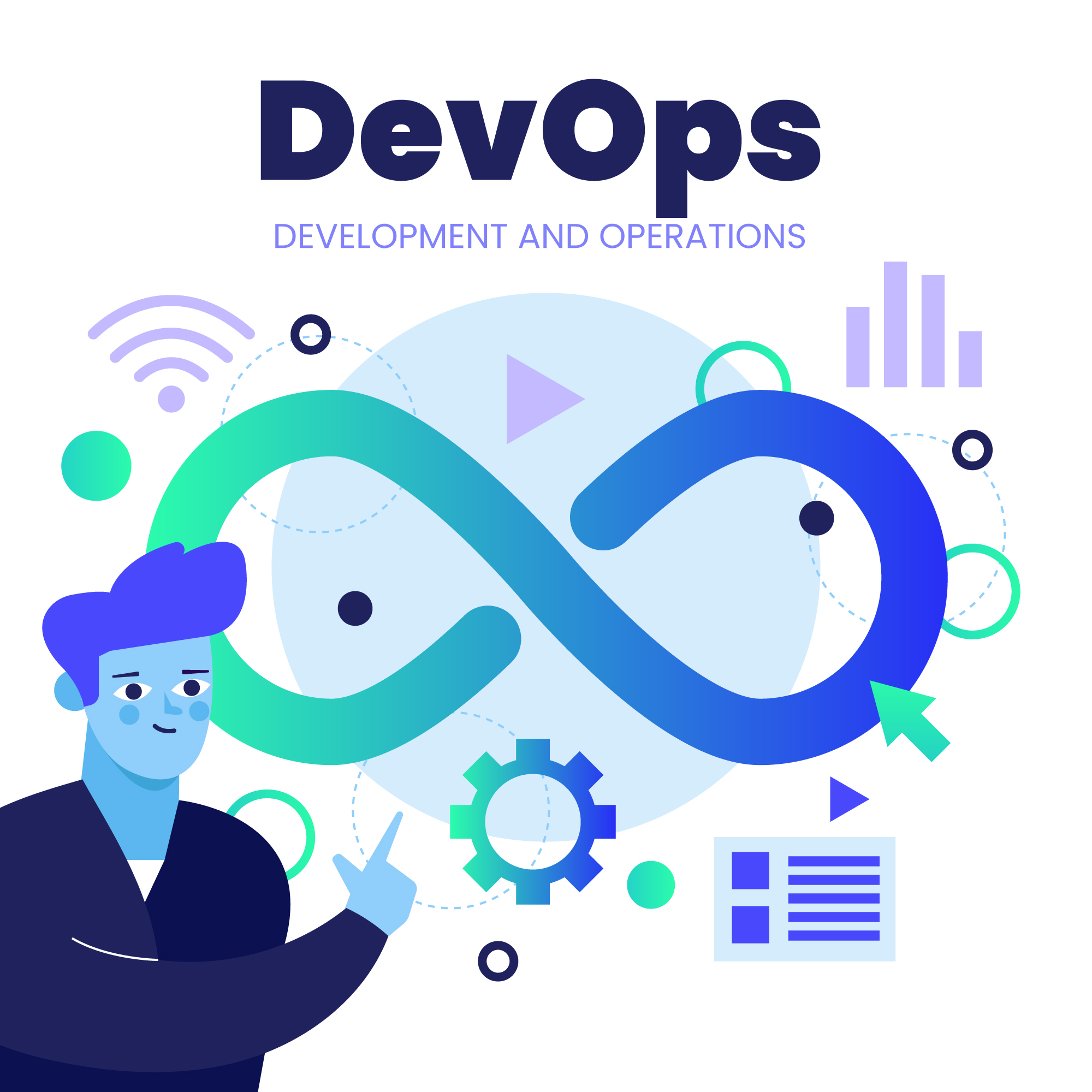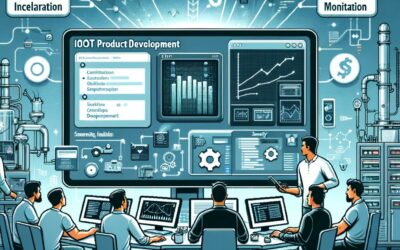Organizations are able to quickly build, deploy and update their applications with minimal disruption using the advanced DevOps processes. The components of a well-built DevOps pipeline consist of several tools, automation steps and allow continuous iterations.
The DevOps pipeline can benefit IT enterprises in several ways. But it is crucial to know the whole timeline and key components of the process. The DevOps lifecycle consists of four distinct phases: planning, coding, testing and deployment. Let’s discuss an overview of all the details of the main components of DevOps process.
DevOps Lifecycle
DevOps is a software development strategy combining the traditional Development and operations aspects into one streamlined process. At its core, the DevOps lifecycle promotes rapid, reliable software delivery through automation. The DevOps lifecycle is built around five distinct stages. These stages include plan & track, CI/CD, test & deploy, monitor & optimize, feedback & operationalize – each with its own unique functions and objectives.
Utilizing this creative process can vastly reduce an organization’s timeframe for producing high-quality software solutions that meet customer needs. Ultimately it helps create a smoother transition from Development to operations. Hence, this results in a quicker time-to-market for products and services. Additionally, by leveraging this methodology, organizations can scale up their software delivery faster than ever!
Key Components of DevOps
DevOps is a technology-driven concept that accelerates the process of Development and operations of software solutions. DevOps focuses on collaboration between developers, operations teams, and other stakeholders for better communication and performance. All the components in DevOps, together, ensure speed. Also, the quality of DevOps teams’ work process also impacts the DevOps lifecycle.
Continuous Development
DevOps relies heavily on Continuous Development. This practice uses automated processes and repeatable sequences over time to ensure that development projects remain on track. Tasks like regression testing ensure quality control, while automated builds and deployments keep applications running smoothly in production.
CD offers a proactive software development method, allowing teams to benefit from fast feedback cycles and incremental launches or versions of their product. Furthermore, it allows for team transparency. This practice helps to track progress in real time with little room for deviation from the project’s scope.
Collaboration
This stage emphasizes the importance of collaboration between development teams. Also, it ensures that code changes are reviewed, tested, and integrated promptly. This can be achieved through version control systems, code reviews, and agile methodologies.
Automation
This stage involves the use of automation tools to streamline the development process, reduce manual errors, and improve efficiency. For example, developers can use automation tools to build and test code automatically or to deploy code to test environments.
Reusability
This stage involves the creation of reusable code components that can be used in multiple projects. Modular programming techniques and the creation of libraries and APIs are used to achieve the best results.
Continuous Integration
Continuous integration combines the development and release processes to continuously monitor, test, and integrate the code changes into the mainline code base. CI workflow begins by pushing code changes from developers’ local machine to a CI server where through automated pipelines, each change from every developer is built and tested on demand.
CI allows for quick identification of errors and increased collaboration throughout the development process resulting in improved product quality and accelerated time-to-market. In addition, CI provides multiple benefits by including some key aspects:
Automation
This stage involves the use of automation tools to integrate code changes into the main codebase on a regular basis. Automated integration helps catch and resolve conflicts between code changes early in the development process, reducing the risk of bugs and downtime.
Testing
This stage involves testing the integrated code to ensure it meets the desired requirements and functions as intended. Testing can be automated, with tests being run every time code is integrated into the main codebase, helping to catch and fix issues early.
Feedback
This stage involves providing Feedback to development teams on the quality and performance of the integrated code. Feedback can be in the form of reports, notifications, or visual representations of code changes, helping to improve collaboration between teams and ensure that code changes are integrated smoothly.
All these factors ensure high-quality output when releasing new features making it a valuable component of DevOps.
Continuous Deployment
Continuous Deployment has become an enormously popular concept in the world of software engineering. It takes DevOps concepts to a whole new level, allowing applications and other code modifications to be applied near-real time.
Monitoring
This stage involves monitoring the production environment to ensure that code changes function as intended and meet the desired requirements. With notifications being sent in the event of any issues or performance degradation, monitoring can be automated.
Rollback
This stage involves the ability to roll back code changes in the event of issues or performance degradation. Rollback helps to ensure that code changes can be reversed quickly and with minimal downtime, reducing the risk of bugs and improving the user experience.
Scalability
This stage involves scaling the production environment to meet changing demands. Scalability can be achieved through the use of automation tools, as well as through the creation of scalable and highly available architectures.
By embracing Continuous Deployment, businesses can achieve faster and more efficient software delivery and improved collaboration between development and operations teams. Furthermore, this revolutionary concept is changing the scope of software engineering and revolutionizing how enterprises produce and deploy applications.
Continuous Monitoring
Continuous monitoring is an important process when it comes to ensuring data safety, security, and accuracy. This is especially true in today’s digital age, where critical information is stored and transmitted electronically. It involves gathering real-time data on events and activities within a given system or network, so any deviations from normal behavior can be quickly monitored and addressed. The key components of continuous monitoring as follows:
Automated Alerting
This stage involves using automated alerting to notify teams of issues and performance degradation. Issues are detected and resolved quickly, to improve the user experience , through automated alerting.
Root Cause Analysis
This stage involves using monitoring tools to analyze the root cause and identify the underlying cause of issues. Root cause analysis helps to resolve issues quickly, reducing the risk of downtime and improving the user experience.
Performance Optimization
This stage involves monitoring tools to optimize the performance of software systems. Performance optimization helps improve the user experience and ensure that software systems function as intended.
Continuous monitoring is useful for detecting anomalies and malware that could go unnoticed or escalate into more significant threats if not attended to promptly. It is an invaluable tool for companies, organizations, and individuals looking to protect their data from malicious actors or unauthorized access.
Continuous Feedback
Incorporating continuous Feedback into DevOps environments is a key driver of success. By doing so, teams can receive real-time insight into the performance and scalability of their systems. Additionally, automated feedback systems help teams make informed decisions faster than would otherwise be difficult with traditional manual methods. Following are some of the key aspects of Continuous Feedback:
User Feedback Collection
This stage involves the collection of Feedback from users and stakeholders. Feedback can be gathered through various methods, including surveys, user testing, and product analytics. By collecting Feedback early and often, development teams can better understand the needs of their users and prioritize improvements.
Feedback Integration
This stage involves the integration of user feedback into the development process. Feedback is used to inform the design and Development of new features and identify areas for improvement in existing software systems.
Continuous Improvement
This stage involves the continuous iteration and improvement of software systems based on user feedback. Development teams work to resolve issues and implement new features, ensuring that software systems meet the needs and expectations of users.
While there are many benefits associated with continuous Feedback in DevOps environments, it is crucial to remain mindful of continuously evaluating current processes and making adjustments when necessary.
Continuous Operations
Continuous operations is an important business concept that involves keeping processes and services running continually. It’s vital for organizations in various industries, as they rely on being able to keep offering services without interrupting their customers.
Continuous Integration
Continuous Integration (CI) is the process of continuously merging code changes into a single codebase. Automated tools like Jenkins and TravisCI can automate the CI process, reducing manual errors and speeding up the process.
Continuous Testing
Continuous Testing (CT) is the process of testing software continuously throughout the development cycle. This includes both automated and manual testing, and it helps ensure that software is high quality and ready for Deployment.
Continuous Deployment
Continuous Deployment (CD) is the process of automatically deploying code changes to production as soon as they have passed all required tests. To automate the deployment process, reducing manual errors and speeding up the process, automated tools like Ansible and Puppet are used.
With proper planning, a business can maintain up-time to the highest possible standard to provide the best customer service experience. This makes continuous operations an important tool for any business that hopes to stay competitive and deliver quality goods or services in the long run.
Building A DevOps Pipeline
Building a DevOps pipeline is an essential part of modern software development. With DevOps, businesses can streamline their software delivery process and reduce the time to market for new features and releases. An effective DevOps pipeline requires specific key components to operate efficiently. These components include
- CI/CD framework
- Source control management system
- Build automation tools
- Code testing framework
Additionally, pipeline tools for container security and infrastructure as code (IaC) security can also be incorporated to enhance the overall security of the pipeline.
CI/CD Framework
A CI/CD framework is a set of tools and processes that automate the software delivery process, from code integration to Deployment. A CI/CD framework aims to help businesses deliver high-quality software to customers faster and with greater reliability.
Source Control Management
Source control management systems, such as Git, provide a centralized repository for storing and managing code. This process makes it easier for teams to collaborate on code, track changes, and maintain a clear version history.
One of the key benefits of source control management is that it enables teams to work simultaneously on the same codebase. Hence, making it easier to merge changes from multiple developers into a single codebase.
Build Automation Tools
Automation tools help to improve the speed and reliability of the software delivery process. Many build automation tools are available, including open-source tools such as Jenkins, Travis CI, and CircleCI, as well as commercial tools such as Bamboo and TeamCity. When choosing a build automation tool, it is crucial to consider factors such as the size and complexity of your software projects, the number of developers on your team, and your budget.
Code Testing Framework
Code testing frameworks play a critical role in ensuring the quality and security of software. One of the key benefits of code testing frameworks is that it allow teams to test code automatically without manual intervention. This helps to ensure that all code changes are tested and validated before they are deployed. Also, this reduces the risk of bugs and other issues making it into production.
FAQs
What Are The Core Benefits Of DevOps?
To get the full fledge advantages of DevOps, it is necessary to follow the DevOps best practices. Here are some of the core benefits of DevOps:
Faster time-to-market: DevOps enables businesses to deliver software faster and more frequently, which helps keep pace with customers’ changing needs and stay ahead of the competition.
Improved collaboration: DevOps promotes collaboration between development and operations teams, which helps to break down silos and improve communication and coordination.
Increased efficiency: DevOps automates many manual processes, reducing the risk of human error and improving the efficiency of software delivery.
Improved quality: DevOps incorporates testing and quality assurance into the development process, which helps to catch bugs and other issues early, reducing the risk of production issues.
Increased security: DevOps focuses on security as a continuous process, which helps improve software security and reduce the risk of security breaches.
Better feedback: DevOps enables businesses to receive real-time feedback on software delivery processes, which helps identify and address issues early.
How Do DevOps Certifications Help?
DevOps certifications allow businesses to demonstrate their commitment to continuous learning and professional Development. In addition, by obtaining DevOps certifications, businesses can demonstrate their commitment to best practices in software development and delivery.
Following best practices and adhering to industry standards, businesses can improve the overall quality of their software. Additionally, the right DevOps outsourcing partner will demonstrate their commitment to DevOps practices to differentiate themselves from their competitors.
Key Takeaways
The DevOps lifecycle is a continuous process that involves collaboration between Development, operations personnel’s to create, deliver and maintain applications. By implementing these key components, businesses can improve the speed and reliability of their software delivery processes. Also, this will reduce the risk of bugs and other issues and improve the overall quality of their software. In addition, DevOps can help businesses to improve collaboration between development and operations teams, increase efficiency, and stay ahead of the curve.




